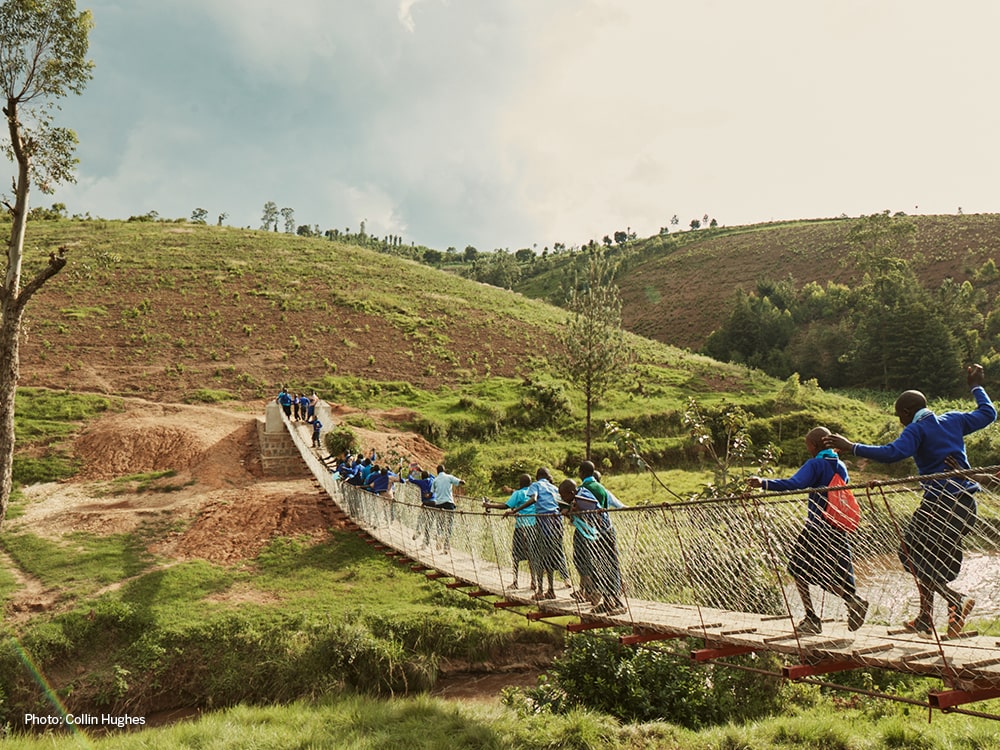
When a dramatic thunderstorm sweeps over Texas, the first question that often comes to mind is, “Where did I put my umbrella?” But, in many impoverished and isolated rural communities around the world, the implications are far more drastic — and the question is more likely to be, “How many weeks will I have to wait before I can get to school?”
Due to the lack of infrastructure required to safely cross flooded areas, sustained rainfall in these communities can wash away access to health care, education and economic opportunities for months at a time.
Thankfully, there is a solution to this widespread problem in the form of simple but effective footbridges that can connect isolated communities, eliminate weather-dependent access issues and provide a safe, reliable pathway.
After accumulating over 30 years of experience in the construction industry and establishing himself as one of North America’s outstanding bridge builders, Texas Engineering alumnus and senior vice president at Parsons, Elie Homsi (B.S. Civil Engineering 1986), found himself playing a critical role in this solution.
While working in a previous role at Flatiron Construction, he was introduced to Bridges to Prosperity (B2P), an organization dedicated to partnering with local communities, partners and foundations to build footbridges that connect residents to vital resources they need to thrive. When Flatiron selected B2P as their giveback partner, Homsi experienced the organization’s humanitarian impact firsthand.
Transforming Lives
Bridges to Prosperity creates opportunity for individuals in rural, isolated areas by providing communities with year-round access to key resources like health care, education and economic opportunity through the construction of footbridges. When industry partners, like Flatiron, choose to sponsor Bridges to Prosperity, they have the opportunity to send up to 10 employees to help finish the bridge construction, bringing their perspective and expertise to the project in the last two weeks of construction.
Homsi and his fellow engineering industry partners take pride in B2P’s resourceful usage of materials. The cables for suspensions are repurposed from shipping ports and from general contractors around the world and then shipped directly to the program countries, where they are inspected to ensure they can handle the necessary weight, then cut and transported to the communities. Bridges to Prosperity partners with individuals from within the community and the sponsoring industry team to assist with construction and show participants how to maintain their bridges.
Answering the Call to Help
Growing up with a father who was an engineer, Homsi wasn’t always enthusiastic about the idea of following in his father’s footsteps. But, his father encouraged him to pursue engineering as a “back-up plan” while Homsi explored other areas.
“I was hooked on engineering once I got involved with research at UT,” Homsi said. “I could finally see how new innovations and discoveries in construction engineering could make lives better — I really could make an impact.”
After Homsi became familiar with B2P’s work, he knew he wanted to get involved. His first project was to assemble a team of top engineers to begin designing and constructing a footbridge in a selected location.
“The people on my team had previously worked on some of the most renowned, record-breaking structures in the world,” Homsi said as a smile spread across his face. “And, you know what? They all now have a picture in their office of the first footbridge they built because it is the bridge they are the proudest of. They know that this bridge truly changes lives.”
Homsi was fortunate to witness firsthand the extraordinary impact that these footbridges have on their communities. But, one memory in particular hits close to home.
When Homsi’s daughter was 14 years old, she accompanied him on a project in Nicaragua. She was interested in paleontology at the time, so the trip seemed like the perfect “study abroad” opportunity to explore her interests. Little did Homsi know that she would be so inspired after a week spent helping build bridges that she would later decide to pursue her own career in engineering.
“That trip changed her life,” Homsi said. “She came back and began to volunteer with the bridge-building effort every summer. She found a deeper purpose for her life, and she’s now a mechanical engineering student who designs prosthetics, working to change lives through engineering. I couldn’t be prouder.”
Using Your Talents to Change the World
For engineering students, it can be challenging to find time in an already full schedule to give back. While Homsi believes that students should be devoted to their education — the foundation upon which they will build a successful career — he also believes you can start small and work your way up to larger initiatives once you graduate from college.
His advice to students interested in giving back is to find a charity whose needs align with the skills and talents you offer. Reach out to that charity, and then watch how quickly your passion grows while helping others.
“This is the biggest reward you can receive,” Homsi said. “Building these bridges has changed my life and how I view the power of engineering — it is the biggest honor to be able to use my education to truly change the world.”







